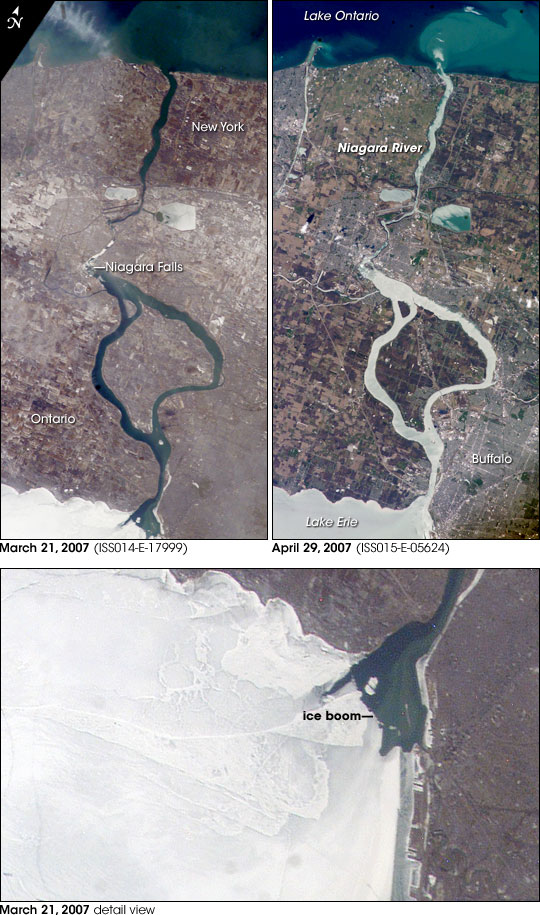


What a difference a month makes! These two images of the Niagara River draining Lake Erie (bottom) into Lake Ontario (top) were acquired about a month apart (March 21 and April 29, 2007, respectively) from the International Space Station. The pair documents the breakup of the Lake Erie ice pack, the unofficial signature of spring for residents of Buffalo and Niagara Falls. In March, the eastern end of Lake Erie is clogged with ice that is pushed against the shoreline by the prevailing westerly wind. The ice collects in Lake Erie, and the Lake Erie-Niagara River Ice Boom prevents it from flowing down the Niagara River, which is the international boundary between the Canadian Province of Ontario, and New York State.
The 2,680-meter (8,800-foot) boom is deployed each December. Operational since 1964, the boom serves several functions: it protects the water intakes for the Niagara River power plants, and it minimizes ice runs (large blocks of ice flowing downstream as ice breaks up in the spring) and blockages that can create damage and flooding along the river. At the height of winter, the thickness of the ice at the Buffalo harbor can reach 3.5 meters (12 feet). The removal of the ice boom, usually in early April, is now marked by local celebrations. This year the boom was removed in mid-April, a bit later than usual. A webcam allows remote viewers to monitor ice pack at the boom.
During their missions, astronauts track the changing seasons using such indicators as the springtime melting of ice packs in high-latitude oceans and lakes. Over the next two years, the space station astronauts will make these types of observations to support International Polar Year (IPY) investigations. Scientists interested in requesting high-latitude imagery from the space station for IPY science should visit the Johnson Space Center Gateway to Astronaut Photography of the Earth International Polar Year Website.
Astronaut photograph ISS014-E-17999 was acquired March 21, 2007, with a Kodak 760C digital camera using an 180 mm lens; astronaut photograph ISS015-E-5624 was acquired April 29, 2007, with a Kodak 760C digital camera using an 180 mm lens. Both images are provided by the ISS Crew Earth Observations experiment and the Image Science & Analysis Laboratory, Johnson Space Center. The images in this article have been rotated and enhanced to improve contrast. The International Space Station Program supports the laboratory to help astronauts take pictures of Earth that will be of the greatest value to scientists and the public, and to make those images freely available on the Internet. Additional images taken by astronauts and cosmonauts can be viewed at the NASA/JSC Gateway to Astronaut Photography of Earth.